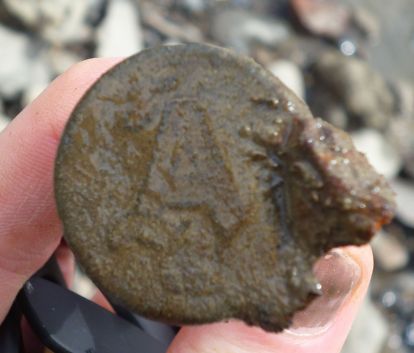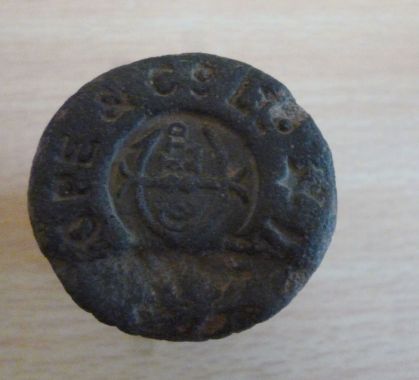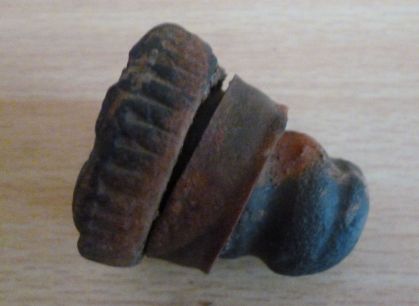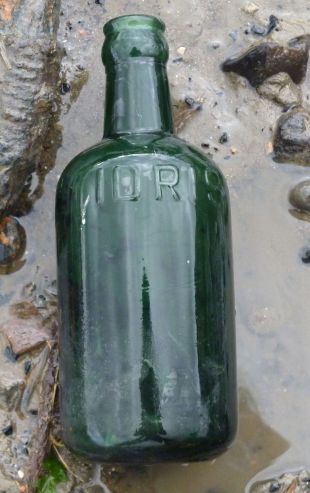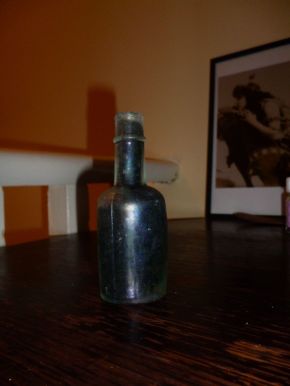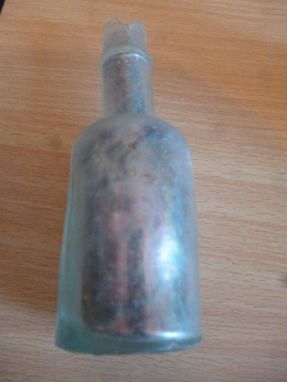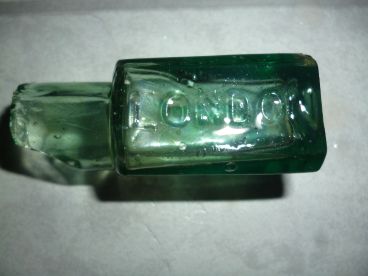2010-2020 A retrospective journey through personal finds
INTRODUCTION
Bottle & glass waste scattered in the mud in 2012
Bottle and glass finds are clues on how Londoners used to live.
For the last decade spent wandering on the Thames foreshore, glass finds have always been on my bucket list (especially bottles).
Talking from my own experience, when I first started exploring the foreshore, bottle and glass finds were more common finds than these days, and I think partially because these were overlooked at the time.
Mudlarking has now become a viral online sensation and a very popular hobby.
With an increasing flock of people regularly visiting the foreshore, grabbing bucketload of finds, some with a specific interest for bottles and glass finds, the best glass and bottle finds are relegated to a chance encounter or so to speak a once-in-a-lifetime opportunity, most likely during a super low tide.
Unlike field bottle digging, wading rivers or buying from antique markets, a good intact and unbroken glass bottle is still a relatively rare find from Old Father Thames, and always a star find for me, one of my favourites.
In 9 years, I only found two intact Hamilton bottles, and a few significant milk, poison and medicinal bottles which have made my day, and I will always remember fondly the moment and circumstances they were found.
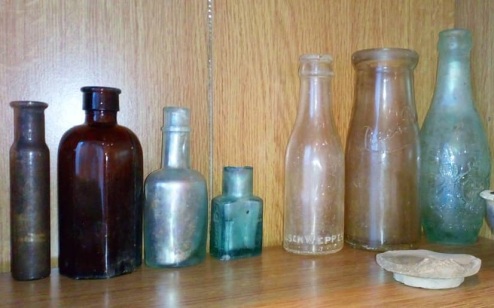
A selection of glass finds from the Thames foreshore
My absolute star of a glass find goes to my Soyer’s Nectar Hamilton bottle, found at a very low tide last winter, sadly broken, but nonetheless a once-in-a-lifetime find, that I was fortunate enough to share with the public as it was exhibited at the Foragers of the foreshore Totally Thames exhibition last year in September.
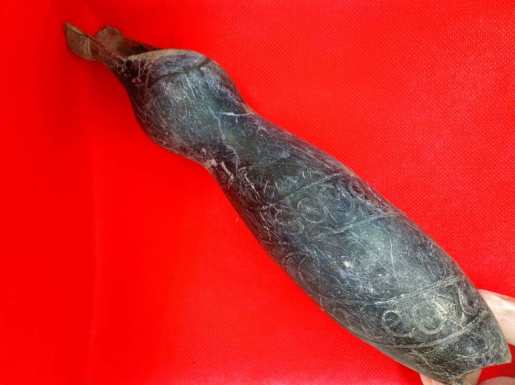
My Soyer’s Nectar before cleaning
Expect to find much broken material in Central London. The action of the tides combined with the Clippers and natural erosion battering any surviving glass find on a foreshore made of a mixture of sand, mud, gravel, bone, organic, stone and brick materials is a natural recipe for disaster.
In addition, some household glass items were already damaged when discarded close-by.
You will find specific areas on the foreshore resembling rubbish dumps, where you can find pottery and early 20th century glass bottles in the same spot.
Mostly modern and Victorian materials are scattered on the Thames banks in central London and, in my case, are the most common glass find.
With some more perseverance and luck, you can find some stylish Georgian vessel glass fragments, earlier date bottle seals, bottle necks, some used for christening ships (my absolute favourite) – some still with the cork and wiring on.

Bottle neck glass fragments ranging from 17th to late 19th century
Broken items have no real value for collectors.
However, glass fragments can be used for learning purposes and are a good clue for archaeologists, a great starting point to familiarize yourself with the different types, forms and functions.
Beware of sharp edges or possible toxic content when handling & collecting glass finds & bottles, in doubt it is advised to wear gloves for general health & safety issues.
From the darkly coloured ‘black glass’ & onion bottles to the square-shaped case gin bottles, to the apothecary & medicinal bottles, mineral waters, glass inks, kitchenalia or breweriana, there are many glass finds to be named and identified on the foreshore.
GLASS DRINKING VESSELS
In my experience, it is very rare to dig glass drinking vessels on the foreshore. Erosion makes it difficult to identify with time, finds uncovered from a sandy foreshore surface or deposited in the mud are much more well-preserved.
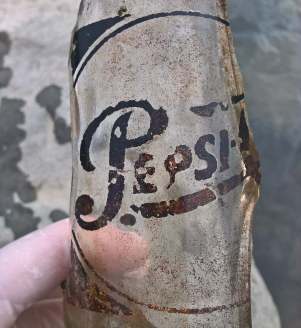
Modern glasses are easily spotted in the vicinity of river pubs, unfortunately my dream find of discovering Georgian or Tudor drinking vessels never happened in the decade I have walked at low tide on the shore.
You may find scarce evidence and broken fragments, but you are more likely to dig parts of bottles and, on a lucky day, find treasure with whole Victorian bottles.
A BOOZE EMPORIUM: WINE BOTTLES, CASE GINS, BREWERY ITEMS
Glass bottles such as spirit & wine bottles only became mass-produced with the Industrial Revolution and the Victorian Period.
Early darkly coloured glass (with hints of brown or green) commonly called ‘black glass’ can be a representative sample of the 17th Century and later Victorian glass production.
Darkly coloured glass could have been part of a sealed onion bottle from the 18th Century, wine bottles or the angular, square-shaped Victorian case gin.
I have no significant finds to illustrate the above, other than fragments of black glass bottle neck, and various shapes ranging from mid-18th to late 19thcentury bottle neck finishes.
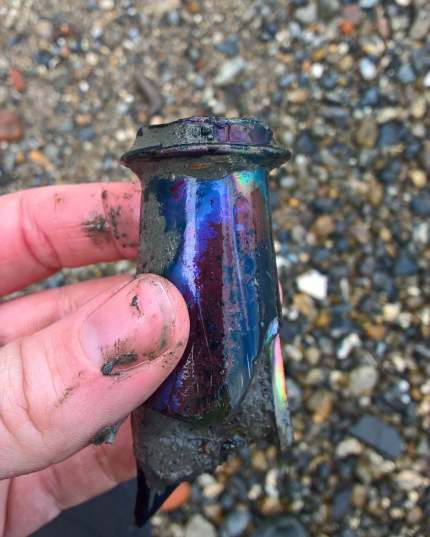
Fragment of an oval-bodied bottle probably c.1670

A bottle neck shape circa 1820s with the cork on

bird’s view of bottle neck with cork
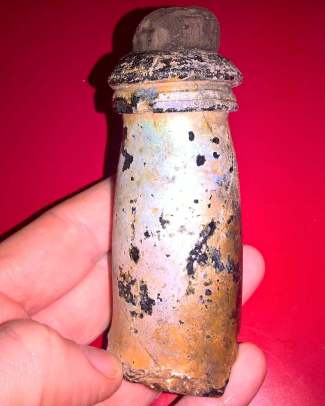
Bottle neck with a cork on c.1815
Older glass finds will often show body imperfections in the shape when not mass-manufactured, as in the two bottle neck fragments shown in the below pictures.
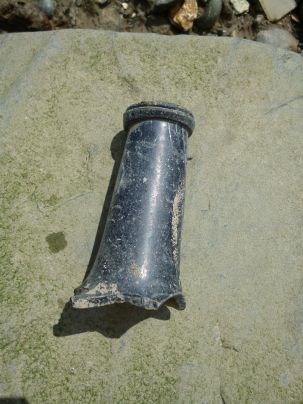
Late 18th Century bottle neck c.1774s
I will add that I have a fascination for finding bottle necks, especially the ones as above with corks still on. To this, there is the romantic idea of wondering why the cork is still on, was it part of a message in the bottle, or placed back when disposed, or more likely a find associated with ship christening as it would have happened on the docks of London quite often.
Proof below is this beautiful fragment of a late 1820s champagne bottle I found, which still had part of the wiring on

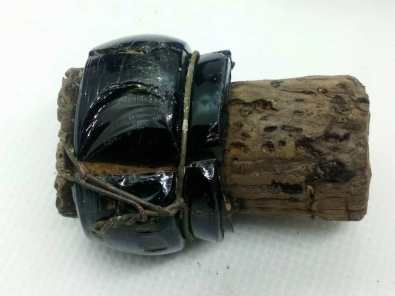


Here is a close up of the late 1820s champagne bottle neck in comparison with an 1860s bottle neck with the cork still on
Vulcanite stoppers can also be found, remembering an age that is now gone.
Glass fragments from brewery items and beers can be found on the foreshore, especially near historical riverside pubs, under bridges, old jetties and causeways.
Below is a fragment of a ginger beer bottle, a much rarer find on the foreshore than the traditional stoneware ginger beer bottle.

Fragment of glass ginger beer bottle
I also found the glass version of the ginger beer stoneware bottle, called Idris, as pictured below :
Idris was another name for the ginger beer popular drink, also found in the form of stoneware bottles
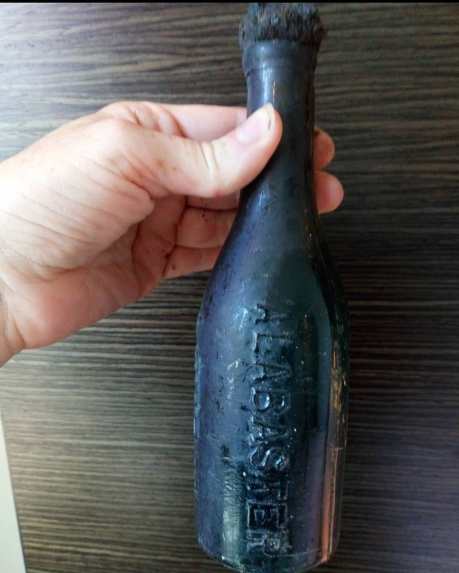
A top find from a super low tide, an alabaster London bottle, still with a corroded cork on
A familiar sight on the Thames foreshore (or so it was when I first started) is the wine bottle bottoms, that seem to survive better than the rest. I love how some of them are huge and imperfect in shape

A selection of big wine bottle bottoms from the foreshore

A huge wine black glass bottle bottom from the foreshore
If you look closely at glass bottle fragments, you may also be lucky enough to find seals, initials or makers/ brewery marks on the fragments.


In addition to fragments of wine bottles, ginger beer and beer bottle, case gins, there are also the odd spirit, liquor or flask fragment to be found. Here is a miniature bottle of old Orkney whisky.

An old miniature of Stromness distillery’s Double O Old Orkney whisky. Stromness closed in 1928 and was demolished in the 1940s, meaning this whisky was produced nearly a century ago.
MILK, JUICE AND SODA BOTTLES
Modern juice, soda and glass milk bottles from different periods and shapes scatter the foreshore and provide bottle collectors with easy finds.
Mass-manufactured glass was also used for soda, thirsty quench cheap drinks or juice bottles. I have not retrieved many fragments to illustrate this sadly, as most of my finds range from the earliest Hamilton, torpedo or Codd-marble shapes detailed in the next section.


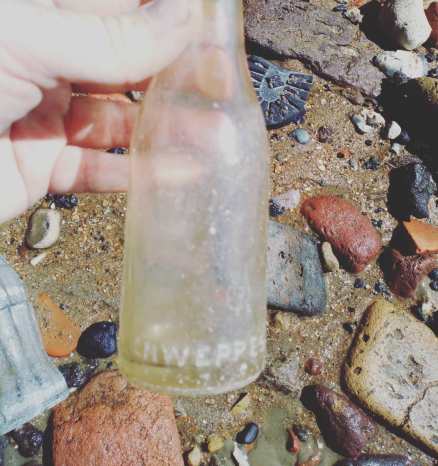
A vintage schweppes tonic bottle
MINERAL WATERS, HAMILTONS & CODD MARBLE-STOPPERED BOTTLES
In the early 1800s, revolutionary methods were used to manufacture artificial mineral water bottles.
At the time, glass bottles were expensive to produce and it was a long-standing problem to keep the fizz of artificial waters and drinks in glass bottles.
HAMILTON BOTTLES
William Hamilton gave his name to the pointed-end glass bottle shape, meant for this purpose of retaining the fizz and freshness.
Hamilton bottles are a star find for bottle collectors and exist in different patents, colours and hybrids.
The bottles are often embossed with the manufacturer label and location, making it easier to identify and date when intact.
Hamilton bottle with inscription ‘Artis Capel & Co Camberwell’ and an embossed St George and the Dragon scene. Artis & Capel was recorded as a Surrey Mineral Water Works company, based in Neate Street, in 1883. I guess it is a rather rare find.
Soyer’s Nectar, Hamilton bottle, circa 1849

The Soyer’s Nectar when recoved from the Thames in 2018
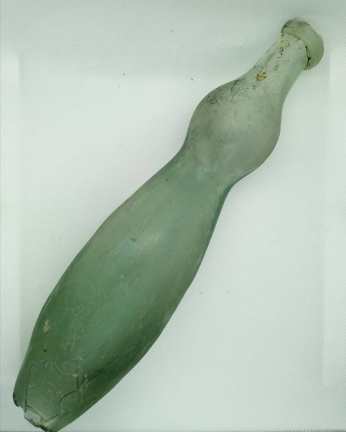
The very elegant and rare shape of Soyer’s Nectar
This is an extraordinary, once-in-a-lifetime find. I found it last winter on an extremely low tide in the mud next to ship timbers I was contemplating, at my favourite river spot. I will remember this day forever. I delicately retrieved it, and wrapped it in my scarf as it was such a delicate and fragile find that had been quite battered in the Thames for over 150 years. Through the find, I embarked on a journey to rediscover the many talents and life of Alexis Soyer, a flamboyant French fellow expat and celebrity chef of the Reform Club in London.

Alexis Soyer’s created his own signature soda, a carbonated blue coloured lemonade drink and a real hit with the Victorian crowd, flavoured with raspberry, apple, quinces, lemon juices and spiced with cinnamon. It was at the time advertised as a hangover cure, with recommendations on how to mix it with rum or sherry for cocktails.

The Soyer’s Nectar once cleaned from the mud

Clever branding and merchandising on the bottle
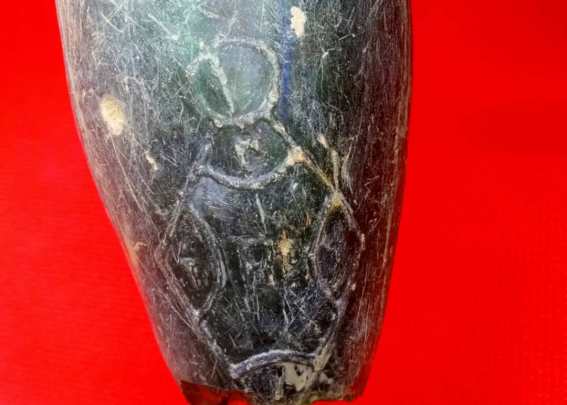
The manufacturing seal of Alexis Soyer on the bottle
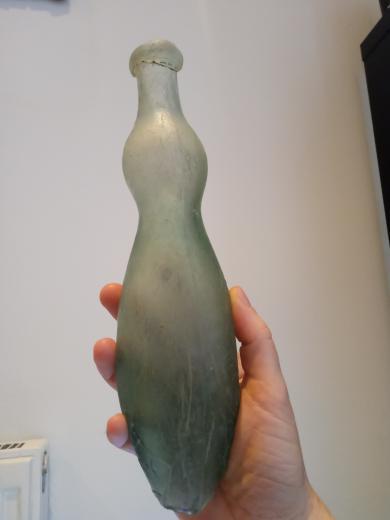
A very unique bottle
Schweppes Skittle Torpedo bottle, early 20th century
Another lovely find from a winter low tide is this stunning Schweppes bottle with Royal Coat of Arms Pictorial.
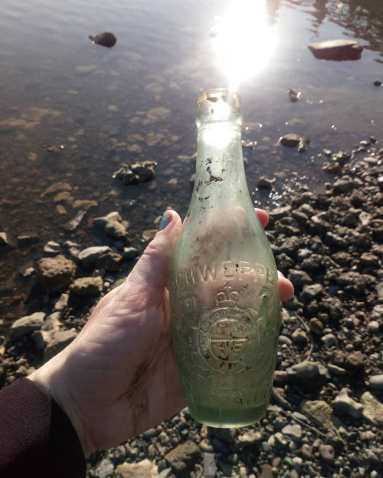
Schweppes bottle as found on site

CODD MARBLE-STOPPERED BOTTLES
In the 1870s, Hiram Codd invented the marble stopper closure for glass bottles, marking a change in the glass bottle trade. Many of these glass marble stoppers can still be found on the foreshore.
Codd marble and glass bottle stoppers from the foreshore
Codd bottles also remain to be found on the foreshore in Victorian rubbish dumps, often broken with the neck missing, as kids used to smash Codd bottles to take the marble stopper to play with.
Codd bottles have a distinguishing shape and embossed lettering on the front.
Codd bottle fragment showing the licence number 66, with embossed letterings: ‘Hussy & Henrich, Kings Cross Trade Mark London’ on the front, ‘Bratby & Hinchliffe Manchester’ on the back.
Bratby & Hinchliffe are registered as ‘engineers to the bottling trades’ and were founded in 1864.
REMNANTS OF A DARKER AGE: PHARMACY & PERFUME BOTTLES, POISON BOTTLES, QUACK CURES & ELIXIRS, FIRE GRENADES…
Many glass finds from the Victorian period remind us of a darker age, the insecurity of the 19th Century, the poor living conditions, the ever-present threat of sickness and the sometimes shameful diseases.
Quack cures & elixirs, pharmacy bottles in a wide range of sizes, shapes & colours were promising ready-made medicines manufactured in the 19th Century.
Early 20th Century glass Medicine bottle
Found during monitoring a stretch of the Thames foreshore for Thames Discovery Programme. One of my favourite bottle find, it’s all about the smooth and soft feel, shape and colour of this bottle.
This bottle was found on the foreshore in an area of Victorian rubbish dump.
For instance, in the 19th and early 20th centuries, druggists, chemists and local perfume & soap factories were located in Southwark near Bankside.
Medicine glass vial, late 19th Century to early 20th Century
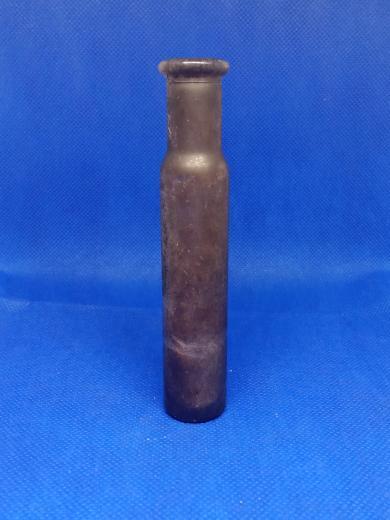
It has the number 20 stamped at the bottom so this is a modern find, probably machine-made and mass manufactured locally in London.
It means a lot to me as it was my first almost intact glass find from my favourite muddy patch of the river. I kept it as I found it, uncleaned, because I love the obscure and gloomy feel to it.
Being a hopeless romantic, I love to imagine it was a narcotic based medicine such as an opium vial, fallen from a doctor’s bag or a domestic medicine chest cabinet, or consumed by an elegantly dressed decadent dandy or poet.
I exhibited this find during the ‘Foragers of the Foreshore’ Totally Thames exhibition in 2019, as one of my top 10 ultimate finds.
Sometimes on the Thames foreshore, you also find more obscure and unidentified glass containers recipients, such as the one below.

I am guessing these had a pharmaceutical or scientific/ lab use, even though I am not certain. It is modern in the making, but I cannot specifically date or attribute this one.
I also found this beautiful iridescent glass bottle neck fragment of an apothecary bottle.

Over the years, I also came across fragments of quack and poison bottles. Not as many as I would like, I am guessing I would have had more luck if I had ventured to the Thames estuary or outside Central London more often.
Poison bottles often had a hexagonal shape, in a light green, brown or dark blue colour, containing toxic and dangerous chemicals.
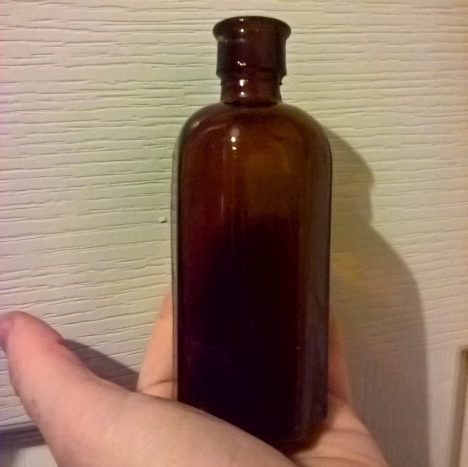
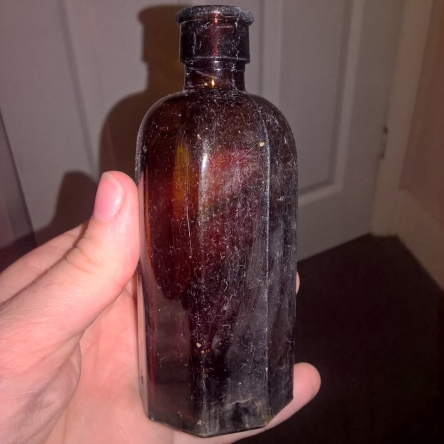
In addition to all the bottle finds described, you will come across glass waste from glassworks and industrial glass production.

A selection of glass waste from the foreshore
GLASS INKS AND KITCHENALIA, FIRE GRENADES
Other glass finds from the 19th Century household were ink bottles, inkwells, kitchenalia items (such as Victorian sauce bottles) or fire grenades.
19th century ink bottle

Fragment of an inkwell
Fire grenades are rare household items; I still hope I can find some significant fragments one day.
Of course, this article is based on my humble finds, and represents only a small percentage of what you can find on the Thames foreshore or other tidal rivers.
*** Please note that you should not visit the foreshore to search for artefacts without obtaining a standard permit from the PLA first. All significant finds must be reported to the Museum of London Finds Liaison Officer. Please respect the restrictions on your standard permit as many sites are restricted for searching and digging on standard permits as well. Consult the foreshore maps prior to your visits. Please respect the archaeology on site and do not excavate, move and remove timbers, anchors, structures or stone features as these are listed and monitored regularly by archaeologists.

